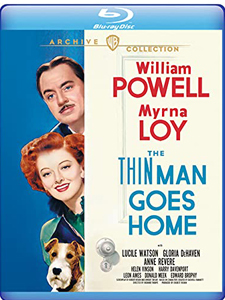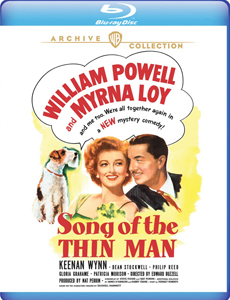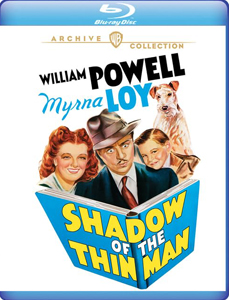The “Thin Man” saga survives its transition away from the original trilogy’s writers (Albert Hackett and Frances Goodrich, working from stories by Dashiell Hammett) reasonably well. Director W.S. Van Dyke and producer Hunt Stromberg are still aboard, smoothing the transition to the fourth entry, “Shadow of the Thin Man” (1941).
And of course William Powell and Myrna Loy are still playing Nick and Nora Charles. Audiences wouldn’t have it any other way, understandably. New writers Harry Kurnitz (a mystery specialist) and Irving Brecher (a comedy specialist) prove to be smart hires.
Slow out of the gates
“Shadow” starts quite slow, as the mistake of giving the Charleses a young son at the end of part two grates in a long opening segment showing their family life. The kid (who will appear again in part six) is cute, but he acts via directorial coaching the same way the family’s beloved terrier, Asta, does. It’s amusing in concept that Nora coaches Nicky Jr. behind the scenes to encourage his dad to drink milk, but not in execution.

“Shadow of the Thin Man” (1941)
Director: W.S. Van Dyke
Writers: Harry Kurnitz (screenplay, story), Irving Brecher (screenplay), Dashiell Hammett (characters)
Stars: William Powell, Myrna Loy, Barry Nelson
When the couple finally gets to the racetrack and a wrestling match, “Shadow’s” energy picks up. Good guest characters pop in — like Alan Baxter, with a great hardboiled voice, as Barrow, and Sam Levene as a police lieutenant who can almost keep up with Nick, but not quite. A mystery builds around fixed horse races and related murders.
Did I follow every twist and turn? No, but there are Hammettian crime details like the baddies using a literal laundry list as a coded way to pass insider information. The writers pick up the thread of Nora trying – and failing (I wish she’d succeed just once) — to help Nick, as well as the often-terrified terrier miraculously finding clues for Nick.
Several gags are smirk-worthy, like when Asta wanders away from the table and Nick – noticing his cocktail glass is empty — announces he’s going to look for the dog at the bar. I admit I found it amusing when an entire restaurant bursts into a Zucker Bros.-esque brawl after a waiter trips over Asta and spills his tray of drinks.
While “Shadow” does move into formulaic territory (it once again ends with Nick gathering all the players in one room to announce whodunit), it hasn’t shed the mystery-crafting principles laid down by Hammett. Get past the drearily slow start and you’ll be off to the races.
3.5 stars

“The Thin Man Goes Home”
By movie five, the original producer had bowed out and director Van Dyke died, leaving Powell, Loy and Asta to carry on the legacy in “The Thin Man Goes Home” (1944). New writers Robert Riskin and Dwight Taylor wisely personalize matters by moving the action to Nick’s hometown of Sycamore Springs. We learn his dad (Harry Davenport), a doctor, doesn’t appreciate that Nick is a master detective – to Nora’s annoyance.

This is the first title that blatantly paints Nick as being “the Thin Man” (the Thin Man is a separate character, only in the first movie), suggesting a kowtowing to the misconception. The comedy generally doesn’t land, despite abortive attempts at colorful small-town characters, such as a budding actress (Gloria DeHaven’s standout Laurabelle) who feels everything “on the inside,” in theatrical fashion.

“The Thin Man Goes Home” (1944)
Director: Richard Thorpe
Writers: Robert Riskin (screenplay, story), Dwight Taylor (screenplay), Harry Kurnitz (story), Dashiell Hammett (characters)
Stars: William Powell, Myrna Loy, Lucile Watson
A major miscalculation is the large and unfunny amount of screen time spent on Nora flailing at her attempts to do detective work. She tracks a suspect and gets in such a jam at a pool hall that she falsely accuses someone of attacking her, triggering a brawl. That’s not particularly admirable.
I get the sense that Loy wasn’t really into this. It’s an interesting time capsule, though, to find Nora being whistled at by every man she passes on the street (even if it is a comedic exaggeration). Another bizarre of-the-time element is the way Asta – despite his owners’ love of him – is treated like an accessory, at one point being checked like a coat!
The mystery is reasonably Hammettian, as a local artist drops dead of a silent gunshot in the Charles family’s doorway. Then we get a parade of people associated with the artist and his in-demand paintings. The revelation is satisfying, and I didn’t guess it. But as a complete package, “The Thin Man Goes Home” never quite arrives at the station.
2.5 stars

“Song of the Thin Man”
Again, new writers and a director come aboard to wrap the series in “Song of the Thin Man” (1947). (There’s no fighting it anymore: Nick Charles is the Thin Man, like Cosmo Kramer is the Assman.) More than ever, it’s in the vein of a formulaic sitcom — although not in a bad way. Indeed, the “Thin Man” movies deserve some credit for inspiring the structure of TV series that repeat a winning formula weekly. Exactly a decade after this, the half-hour “Thin Man” TV series began its run of 72 episodes.
I’m disappointed that the idea of Nora as a worthwhile detective in her own right never got off the ground. She still tries, but is thrown off the scent like a newcomer to sleuthing. She’s witty in dialog, but not in deductions. The film – so named because lounge singing and jam bands play a large role – has good hardboiled lines, but the complete vibe isn’t there.

“Song of the Thin Man” (1947)
Director: Edward Buzzell
Writers: Steve Fisher, Nat Perrin (screenplay); Stanley Roberts (story); Dashiell Hammett (characters)
Stars: William Powell, Myrna Loy, Keenan Wynn
In fact, the comedy gets broad enough in this final installment that it’s sometimes “Naked Gun”-esque, both in a lack of stakes and a veering into absurdism. A liquor bottle in Nick’s hand is shattered by a gunshot and he’s more disappointed in the loss of the booze than the loss of the shooter. In an out-of-place but funny gag, Nora yells “Follow that car!” to a cabbie, and he does – but before Nora can climb in.
The pacing is more energetic than the previous entry, and the mystery of who killed a guy on a cruise ship is mildly engaging. The wrap-up is lightning fast. I appreciate “Song’s” “get in and get out” attitude, but it’s odd that Nick doesn’t get to announce the solution; the culprit for some reason decides to confess. Maybe the person is familiar with Nick’s reputation and wants to get it over with.
While I wouldn’t say the filmmakers are just getting this over with, “Song of the Thin Man” feels like a draining of the tank. Loy has been doing sitcom-style line readings for a while now, and while Powell seems like he could do this forever, he (like Nick) probably didn’t want to. Still – even if not all the sequels hold up under a magnifying glass — fans of Nick and Nora, and Hammett’s extended catalog, should give them a look.
3 stars
Sleuthing Sunday reviews the works of Agatha Christie, along with other new and old classics of the mystery genre.

